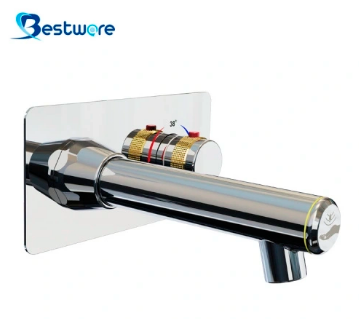Automatic Sensor Faucet, also known as touchless faucets, are becoming increasingly popular in public restrooms, restaurants, and homes. They feature a sensor that detects motion and triggers water flow without the need for manual operation of the faucet handle. In this article, we will discuss the basics of how Automatic Sensor Faucet work.

Sensor Technology The sensor in an automatic sensor faucet uses either an infrared or ultrasonic sensor to detect movement in front of the faucet. The sensor emits a beam of infrared light or sound waves that bounce off an object, such as a person's hand. The sensor then detects the reflected waves and triggers water flow. Water Flow Control Once the sensor detects movement, it sends a signal to the valve in the faucet, which controls the flow of water. The valve is typically a solenoid valve that opens and closes at a high rate of speed to regulate the amount of water flowing through the faucet. Power Supply Automatic sensor faucets require power to operate the sensor and valve. They can be powered by batteries or connected to an electrical outlet. Battery-powered faucets typically use four AA batteries and can last up to a year before needing to be replaced. Electrical faucets are connected to a power source and do not require battery replacement. Advantages of Automatic Sensor Faucets There are several advantages to using automatic sensor faucets, including: 1. Hygiene: Touchless faucets eliminate the need to touch faucet handles, reducing the spread of germs and preventing cross-contamination. 2. Water Conservation: Automatic sensor faucets are designed to conserve water by reducing wasteful flow or leaks caused by human error. 3. Convenience: Automatic sensor faucets are easy to use and require no physical effort to operate, making them ideal for individuals with disabilities or limited mobility. 4. Cost-effective: Although initially more expensive to install, automatic sensor faucets can save money in the long run by conserving water and reducing maintenance costs. In conclusion, automatic sensor faucets are a convenient, hygienic, and cost-effective solution for water waste prevention and germ control. With their advanced technology, water conservation efforts can be maximized without compromising on the convenience of traditional faucets. Automatic sensor faucets, also known as touchless faucets, are becoming increasingly popular in public restrooms, restaurants, and homes. They feature a sensor that detects motion and triggers water flow without the need for manual operation of the faucet handle. In this article, we will discuss the basics of how automatic sensor faucets work. Sensor Technology The sensor in an automatic sensor faucet uses either an infrared or ultrasonic sensor to detect movement in front of the faucet. The sensor emits a beam of infrared light or sound waves that bounce off an object, such as a person's hand. The sensor then detects the reflected waves and triggers water flow. Water Flow Control Once the sensor detects movement, it sends a signal to the valve in the faucet, which controls the flow of water. The valve is typically a solenoid valve that opens and closes at a high rate of speed to regulate the amount of water flowing through the faucet. Power Supply Automatic sensor faucets require power to operate the sensor and valve. They can be powered by batteries or connected to an electrical outlet. Battery-powered faucets typically use four AA batteries and can last up to a year before needing to be replaced. Electrical faucets are connected to a power source and do not require battery replacement. Advantages of Automatic Sensor Faucets There are several advantages to using automatic sensor faucets, including: 1. Hygiene: Touchless faucets eliminate the need to touch faucet handles, reducing the spread of germs and preventing cross-contamination. 2. Water Conservation: Automatic sensor faucets are designed to conserve water by reducing wasteful flow or leaks caused by human error. 3. Convenience: Automatic sensor faucets are easy to use and require no physical effort to operate, making them ideal for individuals with disabilities or limited mobility. 4. Cost-effective: Although initially more expensive to install, automatic sensor faucets can save money in the long run by conserving water and reducing maintenance costs. In conclusion, automatic sensor faucets are a convenient, hygienic, and cost-effective solution for water waste prevention and germ control. With their advanced technology, water conservation efforts can be maximized without compromising on the convenience of traditional faucets.
Bestware Hardware Production Co., Ltd. is an enterprise integrating research, design, development, production, sale, service and combining domestic & foreign trade. Our main products are Touchless Faucet, Drinking Bubbler Tap, Pre-rinse Faucet, Sink Faucet, etc.For more inquiries, please contact us:
Tel :+86-0750-3108801
Mobile Phone :+8613929008801
Email :sales@bestwaremfg.com



